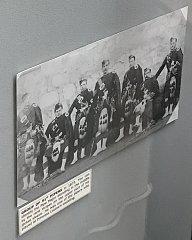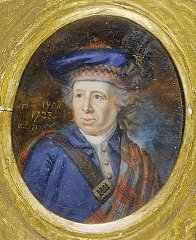|
-
10th April 18, 12:51 PM
#1
Diced Glengarry.
Hello all.
I have read some information about the origin of the diced trim in the Glengarry but there's a lot of different theories. Is there any accepted theory about when and why it's wear for the Scott's?
Why the solo pipers don't wear it?
Thanks to all.
-
-
10th April 18, 06:12 PM
#2
First, remember that the Glengarry is a relatively recent development, and is essentially a blocked Balmoral bonnet. Glengarries were adopted by the Regular Scottish regiments beginning in the 1840s.
As best I can recall dicing begins appearing on Scots bonnets in the mid-18th century.
Initially the dicing was a single row. By the late 18th century three-row dicing had become standard in the Scottish regiments.
How it originated is perhaps open to some speculation. I've often heard the theory that a ribbon began to be set into the bottom edge of the bonnet, laced in and out of a number of slots, and tied at the back, in order to adjust the size of the bonnet.
The Black Watch and The Cameron Highlanders have long worn plain Glengarries, that is, without dicing.
As to why pipers of all regiments wear plain Glengarries, remember that the typical military piper's costume was devised in the 1840s for the pipers of The Cameron Highlanders, and later adopted by the other regiments. Certain Cameron-specific features of the costume (the plain Glengarries and the green doublets) were adopted without change by the other regiments. (One would have expected diced Glengarries and yellow doublets with the pipers of The Gordon Highlanders, for example.)
Time for pretty pictures!
Mid-18th century painting showing a red band around the bottom of the traditional blue Scots bonnet

Fully developed three-row dicing by the end of the 18th century

An early Glengarry worn with civilian costume prior to Glengarries being adopted by the army

Bonnet with one-row dicing in the 1860s, by which time it seems to have been rare

Two Sergeants of the 78th Highlanders pre-1881, plain Glen for the piper and diced Glen for the non-piper soldier

Last edited by OC Richard; 10th April 18 at 06:45 PM.
Proud Mountaineer from the Highlands of West Virginia; son of the Revolution and Civil War; first Europeans on the Guyandotte
-
The Following 4 Users say 'Aye' to OC Richard For This Useful Post:
-
11th April 18, 12:25 AM
#3
Lots of information here. Thanks Richard.
-
The Following User Says 'Aye' to PIPER IŅAKI For This Useful Post:
-
12th April 18, 06:31 AM
#4
 Originally Posted by OC Richard

As to why pipers of all regiments wear plain Glengarries, remember that the typical military piper's costume was devised in the 1840s for the pipers of The Cameron Highlanders, and later adopted by the other regiments. Certain Cameron-specific features of the costume (the plain Glengarries and the green doublets) were adopted without change by the other regiments. (One would have expected diced Glengarries and yellow doublets with the pipers of The Gordon Highlanders, for example.)
The only exception in the rule "pipers of all regiments wear plain Glengarries" was 91st Regiment (Argyllshire Highlanders) where the pipers wore feather bonnets (like Black Watch pipers) and diced glengarries until (and in fact even in few years after) amalgamation with 93rd Regiment to form Argyll & Sutherland Highlanders in 1881...

sorry for quality of picture
Last edited by blackwatch70; 12th April 18 at 06:43 AM.
-
The Following User Says 'Aye' to blackwatch70 For This Useful Post:
-
12th April 18, 07:09 AM
#5
It occurs to me that I've not spent a lot of time looking at bands' bonnets so I don't know if it's common to do it this way, but in my (former) band, drummers wore dicing on their Balmorals while pipers did not. Is this the same as "pipers do not wear dicing and non-pipers do" thing? (I never asked anyone in the band.)
Here's tae us - / Wha's like us - / Damn few - / And they're a' deid - /
Mair's the pity!
-
-
12th April 18, 02:12 PM
#6
 Originally Posted by Katia

It occurs to me that I've not spent a lot of time looking at bands' bonnets so I don't know if it's common to do it this way, but in my (former) band, drummers wore dicing on their Balmorals while pipers did not. Is this the same as "pipers do not wear dicing and non-pipers do" thing? (I never asked anyone in the band.)
This is pretty much standard in most pipe bands, in my experience, although there are many exceptions. In police pipe bands, for example, both pipers and drummers generally wear glengarries with black and white dicing, but this is a special case. I have played in a couple of civilian bands where pipers and drummers both wore red-and-white diced glengarries. In my six decades of piping this is the first time I have heard of the "pipers do not wear dicing and non-pipers do" thing. I have seen a good many solo pipers wearing diced glengarries (and balmorals). It really comes down to the individual piper's personal preference.
-
-
12th April 18, 07:02 PM
#7
 Originally Posted by imrichmond

This is pretty much standard in most pipe bands, in my experience, although there are many exceptions.
 Originally Posted by imrichmond

In my six decades of piping this is the first time I have heard of the "pipers do not wear dicing and non-pipers do" thing.
Sorry, I wasn't clear if you were saying it is a common thing for bands to do, or if it is not something you'd seen before.
I did a google image search for "pipe band" and it seems that most do not wear dicing (all personnel the same. The only other time I've heard of it being common for different members to wear different headgear is in bands that wear the feather bonnets; sometimes tenor drummers will wear a Glengarry or Balmoral instead so the headwear doesn't get in the way of flourishing). This will be an interesting question to ask for my own band some time, if it is indeed an unusual practice; no doubt it has roots in some band tradition somewhere, thought I'm not sure if anyone will remember exactly why. Then again, at least for bands I've seen in the U.S., it's uncommon for bands to still wear Balmoral rather than Glengarry as well. (Mine is not currently a competing band, so I don't know if a return to competition would change headwear or not.)
Here's tae us - / Wha's like us - / Damn few - / And they're a' deid - /
Mair's the pity!
-
-
12th April 18, 09:10 PM
#8
Drummers wearing dicing while pipers wear plain is probably not as common as it used to be in pipe bands, but it is standard in the sense that, in bands that choose to wear both diced and plain glengarries, it is the drummers who wear the diced and the pipers who wear the plain ones. I have certainly never seen the reverse. That said, outside of the military, where regimental traditions hold sway, there are no rules other than an individual band's uniform requirements governing the wearing of dicing.
-
-
13th April 18, 05:09 AM
#9
Here are a couple of mid 18th Century images that show that dicing was something that started showing up in later part of the 1750's

The caption says a little different, Im of the mind that this is an officer of the newly raised 2d Bn of the 42nd in 1758

Ive lost my info on this image, if someone has the cite, Id love to have it again. Going to commission a knitter to make me a bonnet with this style of dicing here soon.
-
-
13th April 18, 12:03 PM
#10
 Has a piper I wear a diced Glengarry when playing because it's more colored and I personally like it, but I "never" see a piper in a piping contest wearing a diced Glengarry or balmoral. Has a piper I wear a diced Glengarry when playing because it's more colored and I personally like it, but I "never" see a piper in a piping contest wearing a diced Glengarry or balmoral.
I like the black white and red trim and I thing it's looks very Scottish, a piper with a black trim seems me a bit sad.
-
 Posting Permissions
Posting Permissions
- You may not post new threads
- You may not post replies
- You may not post attachments
- You may not edit your posts
-
Forum Rules
|
|

























Bookmarks